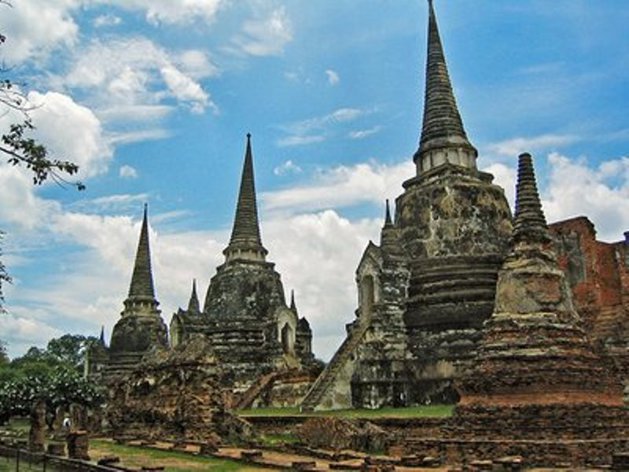vineri, 24 februarie 2012
Tolerance.ro: Romania determined to block Serbia's candidate bid to the EU because of the invention of “Vlach” language
The beginning of 2012 Serbian authorities has continued the plan to invent and standardize a new language “the Vlach language”. The so called Vlachs in Timoc region speak Romanian but they were not alowed to learn it in school.
Daniel Gheorghe: The road for EU integration of Serbia, Cyrillic approaches. Stalin invented ”Moldovan” language, Serbia invents “Vlach” language
YouthVoice.ro: Daniel Gheorghe: The road for EU integration of Serbia, Cyrillic approaches. Stalin invented ”Moldovan” nation and language, Serbia invents “Vlach” nation and language...
 One of the most controversial issues of the European affairs is the creation of fictive national identities in order to assimilate different minority groups inside and extreme nationalist state. This anti-democratic practice was first time elaborated during Stalin totalitarian communist regime. The technique has the purpose to gain and maintain the state control over large spaces and over different nations by using force and persuasion in a large scale strategy. This is done by dividing peoples and nations.
One of the most controversial issues of the European affairs is the creation of fictive national identities in order to assimilate different minority groups inside and extreme nationalist state. This anti-democratic practice was first time elaborated during Stalin totalitarian communist regime. The technique has the purpose to gain and maintain the state control over large spaces and over different nations by using force and persuasion in a large scale strategy. This is done by dividing peoples and nations. The Stalinist example of ”Moldovan” nation and language Stalin, during his terror over the eastern Romanian lands like Bessarabia, developed in the labs of the soviet communist party the so called “Moldovan” nation. This was in reality a fictive nation invented from political and anti-Romanian reasons. In order to understand they are different than Romanians, this new ”nation” needed to have a different language... and since they could not take Russian as mother tongue very fast, the Soviets propagated the idea that the language of the inhabitants of Bessarabia is ”Moldovan”...
The same ”scientific” technique -postmodern approaches Presently, in this postmodern and apparently free Europe this scenario is repeating. Serbia, a candidate for EU membership, neighbour and “historical friend” of Romania, is practicing a constant state policy of dismantling the important Romanian community from the Timoc and Crajna regions in Eastern Serbia.
There are after independent estimations more than 250.000 Romanian ethnics in Eastern Serbia called by the Serbs as “Vlachs”. The Romanian minority based in Eastern Serbia live in the same traditions, language, origin and legacy with their brothers from modern Romania. The purpose to call them “Vlachs” aims to identify them as other ethnic group than the one they are representing. The lack of fundamental rights is a cruel reality when we are speaking about the Romanians from Timoc region. Hunted by the Serbian state, forgotten by the Basescu’s administration of Romania, this minority is struggling for ethnic surviving.
Despite all the Serbian-Romanian treaties and despite all the assurances from the Serbian president and from the Belgrade Government that they plan to give all the necessary rights to Romanians in Timoc, the situation of those forgotten Romanians is getting worse. With all the commitments regarding the rights of minorities taken by the Serbian policy makers on the road to European integration, the reality of the practice on the field of dealing with national minorities is telling us a different story.
The invention of the “Vlach” nation using the old Bolshevik model is a significant obstacle towards the democratization of Serbia and a very unfaithful act on the relation with Romania, a country which has many political ties with Serbia and which has a long history of bilateral relations with this south-western neighbour. There are no “Vlach” people and there cannot be any Romanian language written with Cyrillic alphabet (“Vlach language”) .
More than this diversion with this fictive nation, there are other aspects of violating the international conventions on the protection of minorities such as the involvement of the state authorities in the issues of self-organization of the Romanian minority in Serbia. This illegal policy of forced control over the civil organizations is a proof that Serbia is still having big problems with breaking with the authoritarian past.
We think that the situation of Timoc and Crajna must be dealt as a European political issue and this unpleasant problem is necessary to be put on the attention of the European Parliament and Council of Europe. Meanwhile, on the process of ratification of the EU-Serbia association and stabilization treaty, the question of the rights of the Romanian minority from Eastern Serbia cannot be missed. The convention over this European issue should be a part of a separate addendum chapter of Serbian-Romanian relations besides the EU – Serbia association agreement.
We think that is the obligation of the Romanian and European authorities to take a stand on protecting minorities’ rights from Serbia. The Serbian government should understand that protecting the rights of Romanian minority, they are helping their own society in the process of reopening to the world and in the process of cooperation in the south Eastern Europe.
The “Vlach” term is a derogatory for “Romanian” and it is the duty of the Romanian authorities, of the Romanian Parliament and of the Romanian parties to understand that we have the moral right to convince the Serbian state that recognizing the Romanians as Romanians and not as “Vlach”, the opening of Romanian schools (or Romanian lessons in schools) andRomanian orthodox churches in Timoc , giving those people civil and cultural rights (such as access to mass-media in the mother tongue ) is a legal and moral “must”.
Daniel Gheorghe
Sursa: Romanian YouthVoice.ro
Romanian YouthVoice.ro: “Lucky” Romanians: native speakers of three languages: Romanian, Moldovan (a Soviet fake), Vlah (a Serbian fake)
Romanian YouthVoice.ro: “Lucky” Romanians: native speakers of three languages: Romanian, Moldovan (a Soviet fake), Vlah (a Serbian fake). Serbia on the way to create huge diplomatic scandal with Romania
 The beginning of 2012 gives the linguists a new area of study. Serbian authorities are planning to invent and standardize a new language “the Vlach language” Romanian YouthVoice.ro reports.
The beginning of 2012 gives the linguists a new area of study. Serbian authorities are planning to invent and standardize a new language “the Vlach language” Romanian YouthVoice.ro reports. The National Council of the Vlah minority, which should represent the interests of the Vlach/Romanian minority in Serbia was overtaken by Serbian parties in 2009. More exactly, Serbian authorities have allowed and encouraged nonVlachs/nonRomanians to participate for this election. Thus, the Serbian parties were allowed to participate and took control of the Council. From that moment, the activity of the Council was directed for the replacemt of the Romanian language in Timoc Valley (a Romanian majoritary area) of Serbia with a new invention, the “Vlah language”.
Thus, at the beginning of 2012 the pioneers of this stupidity have created already a new alphabet that is ready to be imposed to the Romanians (Vlachs) in Timoc…
Soviet model
We all know that after ocupying the eastern part of the Romanian principality of Moldova in 1812, the Russian Empire and latter on the Soviet Union have continually tried to tell the inhabitants of this teritory that they are not speaking Romanian but Moldovan.
Now, there are still some remainings of this histirical clash:
-the Declaration of independence of the Republic of Moldova from 1991 sais Romanian is the state language;
-the Constitution of the Republic of Moldova from 1994 (modified by Agrarians -Comunists-) sais Moldovan is the state language;
The officials in the Republic of Moldova have also diffrent opinions about the same language:
-the prime minister speaks Romanian;
-the President of the Parliament (interim President of the Republic) sais he speaks Romanian from the schientific point of view and Moldovan from the political point of view;
-the leader of the Liberal Party from the governing alience sais he speaks Romanian;
-the communits in the oposition, the remainings of the soviet times, speak Moldovan;
-the Moldovan Academy of Science sais the language of the population of the Republic of Moldova is Romanian and any atempt to call it Moldovan is unscientific.
Transplantation of stupidity
So, as we see, imperialist times of Russia and the soviet ones have created a monster, the “Moldovan language”. A fake name of the language in order to assimilate the population... Due to intense propaganda, some still believe this stupidity.
But what it is even more absurde in the Europe of 2012 is that Serbia, a country that calls itself democratic and plans to European integration, a country that wants good relations with its neighbours, including Romania, a country that need to respect minority rights in order to get closer to its EU objective, this country alows and suports an agression against an important part of its population (the Vlah/Romanian minority) and promotes a scandalous relation with its neigbour Romania.
So, what we can do, is to “congratulate” Romanians for their historical ability to manage to speak their own language three times in one: Romanian, Moldovan and Vlah options, but also we can congratulate Serbia for its succes in restoring “Soviet democracy” after 20 years of its collapse and thus cutting any changes to get closer of the European Union in the near future...
George Cristian Popescu
Source: Romanian YouthVoice.ro
sâmbătă, 18 februarie 2012
Tolerance.ro: Russian Ambassador in Chișinău, Republic of Moldova, to start new diplomatic scandal
Speaking with one representative of the unrecongnised Transnsitria, he confirmed that although Republic of Moldova is against this Consulate, sunner or later Russia will open it…
So, Should we understand that Kuzmin wanted to say that that sooner or later Russian Federation will recognize the independence of Transnsitria ?
Source: Tolerance.ro
SSRN.com: L. Matei, C. Cornea: Human Resource Motivation in Romanian Public Administration – The European Union Enlargement Context
 Abstract. Intrinsic motivation is widely considered by public administration scholars as fundamental for the Public Service Motivation (PSM). In apparently contradiction with the theory of PSM, the extrinsic motivation techniques, such as financial incentives, function better in Romanian public organizations, the reason being in general connected with the payment level for the public servants and their expectations for the work performed.
Abstract. Intrinsic motivation is widely considered by public administration scholars as fundamental for the Public Service Motivation (PSM). In apparently contradiction with the theory of PSM, the extrinsic motivation techniques, such as financial incentives, function better in Romanian public organizations, the reason being in general connected with the payment level for the public servants and their expectations for the work performed.In the context of new legal obligations arisen in the period of joining the European Union, Romanian public authorities recruited more employees . After 2008, influenced by lower budgets and political changes, this dynamic of human resources was inverted, in some places with very significant personnel fluctuations, leading to major misbalances of public service.
Public servants cannot be motivated if they do not have the intrinsic motivation specific for the work in public service as defined by PSM theory. Thus, we consider that the actual recruiting system of public servants in Romania need to be reformed to introduce in public sector well equipped individuals.
Although intrinsic, PSM is not immutable and can be lost. Public servants can loose PSM because of different extrinsic motivational factors (low salary, lack of promotion, permanent structural changes of the organization, manager’s disregard for procedures/law).
An article by Lucica MATEI and Catalin-Ionut CORNEA
National School of Political Studies and Public Administration, Bucharest
Abstract on: http://ssrn.com/abstract=1974001 Social Science Research Network
for Direct download of FULL article you can acces One-Click Download
published in the volume: NATIONAL AND EUROPEAN VALUES OF PUBLIC ADMINISTRATION IN THE BALKANS, pp. 334-352, A. Matei and C. Radulescu, eds. Economica Publishing House, 2011
gandul.info: GALERIE FOTO: Topul celor mai mari oraşe din lume în ultimii 9.000 de ani - de la Ierihon la Tokyo
GALERIE FOTO: Topul celor mai mari oraşe din lume în ultimii 9.000 de ani - de la Ierihon la Tokyo
Timp de nouă mii de ani oraşele, marile aglomerări urbane, au căpătat o importanţă din ce în ce mai mare în dezvoltarea societăţii umane. Jurnaliştii de la Business Insider au prezentat topul celor mai mari 16 oraşe ale omenirii, după populaţia efectivă, din ultimele nouă milenii.
Estimarea cu precizie a populaţiei este un demers foarte greu, majoritatea istoricilor şi a celorlaţi specialişti apelând atât la izvoare scrise cât şi la estimări legate de forţa comercială sau militară a unui anumit oraş pentru a-i estima numărul de locuitori într-un anumit moment în istorie.

Top 16 cele mai mari oraşe ale omenirii din ultimele nouă mii de ani
1. Ierihon - anul 7.000 î.e.n. Populaţie: 2.000. Populaţie actuală: 14.674 locuitori
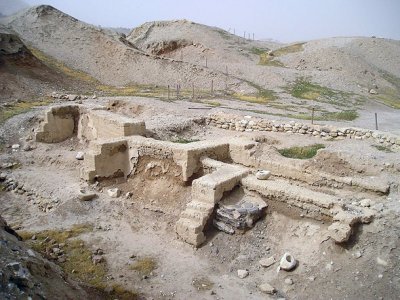
Ierihonul este, după cum susţin unii istorici, şi cel mai vechi oraş din istorie, respectiv oraşul care a continuat să existe, pe aceeaşi suprafaţă ocupată de la bun început, timp de peste nouă mii de ani. Oraşul, situat între Marea Moartă şi muntele Nebo (actualul teritoriu al Palestinei), avea un sistem de irigaţie care avea ca sursă râul Iordan. La finalul preistoriei speciei umane, locuitorii din Ierihon au dat dovadă de cunoştinţe avansate de arhitectură.
2. Uruk - anul 3.500 î.e.n. Populaţie: 4.000 de persoane

Uruk a fost unul dintre cele mai importante centre culturale şi militare ale civilizaţiei sumeriene. Oraşul, care era situat în partea de sud a ceea ce era atunci Mesopotamia, a înflorit arhitectural mai ales în timpul domniei regelui Hammurabi. Cultivarea grâului şi apropierea de râul Eufrat a permis acestui oraş să se dezvolte rapid, sprijinit de agricultură şi comerţ. În prezent pe teritoriul fostului Uruk se află doar ruine.
3. Mari - anul 2.400 î.e.n. Populaţie: 50.000
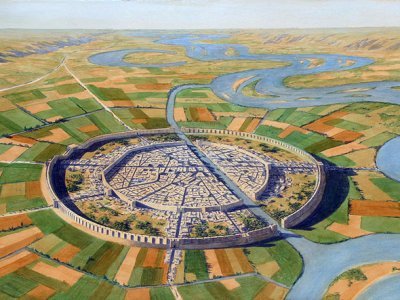
Fosta capitală a Mesopotamiei, imperiul situat între Tigru şi Eufrat (de unde şi numele, care înseamnă "Între râuri"), Mari, a înflorit din punct de vedere economic şi cultural mai ales în secolul II î.e.n. pe baza comerţului cu piatră de carieră, cherestea şi produse agricole. Din oraşul situat pe teritoriul actualei Siria au mai rămas doar ruinele. În anii 1930 un arheolog francez a descoperit în această zonă circa 25.000 de tăbliţe, inscripţionate într-o limbă pierdută de-a lungul secolelor: akkadiana, limbă semitică vorbită în perioada aceea mai ales pe teritoriul actualului Irak.
4. Ur - anul 2.100 î.e.n. Populaţie: 100.000
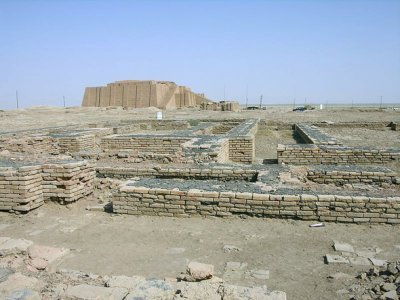
Numele fostei mari metropole sumeriene înseamnă "Cuptor de foc". Dezvoltarea accelerată a acestui oraş s-a datorat şi faptului că a fost unul dintre cele importante porturi din Mesopotamia la acea vreme, toate vasele de comerţ fiind obligată se treacă pe aici şi să plătească taxe. Oraşul, din care acum au rămas doar ruinele, era situat la circa 350 de kilometri sud-est de actualul Bagdad. Unii istorici şi experţii biblici susţin că acesta ar fi oraşul de naştere al profetului Abraham.
5. Yinxu - anul 1.300 î.e.n. Populaţie: 120.000
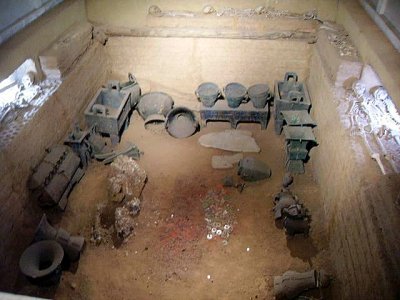
Yinxu a fost pentru o anumită perioadă de timp capitala imperiului condus de dinastia Shang, în nord-estul Chinei de astăzi. Imperiul cuprindea actualele provincii Henan, Hubei, Shangdong precum şi părţi din actualele provincii Shanxi, Shaanxi şi Anhui. Yinxu este recunoscut mai ales pentru bogaţia de scrieri oraculare descoperite la baza ruinelor fostei mari capitale, scriere aplicază pe carapace de broască ţestoasă şi unele oase. În momentul de faţă pe suprafaţa fostului centru al imperiului dinastiei Shang se regăsesc doar ruine.
6. Babilon - anul 700 î.e.n. Populaţie: 100.000
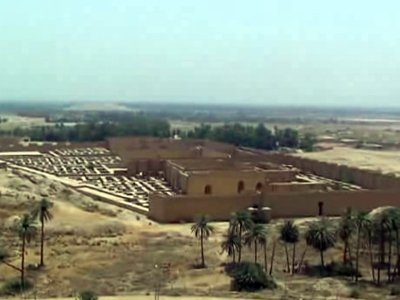
Babilonul este atestat arheologic ca fiind înfiinţat de cel puţin patru mii de ani. Capitala imperiului babilonian (provine din semiticul Bab ilani - Poarta Zeilor) era situată pe malul Eufratului, dominând timp de secole întregul imperiu. Recunoscut cultural atât pentru scrierea cuneiformă cât mai ales pentru codul lui Hammurabi, Babilonul a fost distrus în secolul VII î.e.n. de către asirieni, învingători în războaiele cu babilonienii. Babilonul a renăscut, după prăbuşirea imperiului asirian, sub domnia lui Nabucodonosor al II-lea.
7. Cartagina - anul 300 î.e.n. Populaţie: 500.000
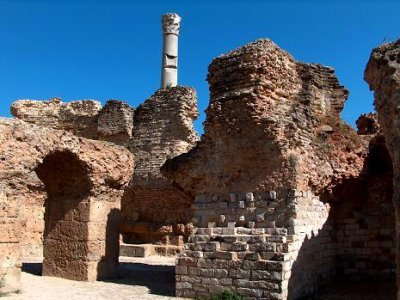
Situat în partea nord-estică a actualei Tunisii (N-E coastei africane), oraşul Cartagina a ajuns, la vârful dezvoltării ei economice şi militare să poarte războaie cu Roma (războaiele punice - 264-164 î.e.n.). Victoria Romei a garantat supremaţia "Oraşului etern" timp de aproape şapte secole. Oraşul-stat nu îşi obliga cetăţenii să lupte, ci prefera să angajeze mercenari. Poate cel mai cunoscut lider al Cartaginei este Hanibal, considerat unul dintre cei mai iscusiţi tacticieni militari din toată istoria. După o serie de victorii Hanibal a ajuns în imposibilitatea de a cuceri Roma fără întăriri, pe care Cartagina nu a vrut să le mai trimită. El a fost nevoit să se întoarcă pe coasta Africii pentru a apăra Cartagina de armata condusă de Scipio Africanul, bătălia finală fiind dată la Zama, în urma căreia oraşul-stat a fost nevoit să se recunoască înfrânt şi să plătească despăgubiri de război Romei.
8. Roma - anul 200. Populaţie: 1.200.000. Populaţie actuală: peste 2.900.000 de locuitori
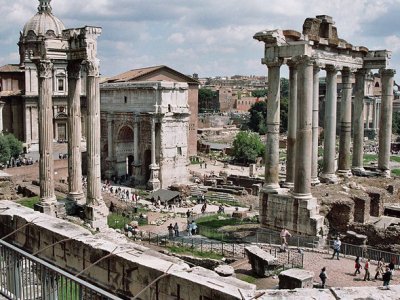
"Capitala lumii" a fost întemeiată, conform legendei, de Romulus şi Remus, în 753 î.e.n. şi, până la începutul secolului IV î.e.n. când a fost asediată de celţi a fost neînfrântă. Capitala imperiului roman este situată pe şapte coline, la fel ca fosta capitală a Moldovei, Iaşi. Poate cele mai cunoscute construcţii din Roma sunt Coloseumul, Panteonul şi Columna lui Traian, pe care sunt sculptate inclusiv scene desprinse din războaiele daco-romane.
9. Constantinopol - anul 600. Populaţie 600.000. Populaţie actuală: peste 18.000.000 de locuitori
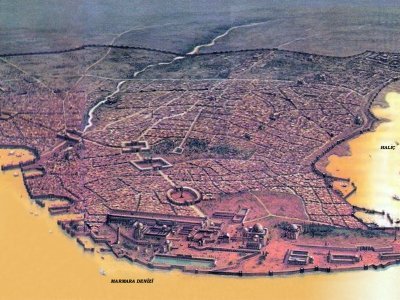
Actualul Istanbul, fostul Bizanţ, Constantinopol a primit denumirea după împăratul Constantin cel Mare, care a declarat Bizanţul de atunci capitala imperiului roman de răsărit. În limba română s-a folosit până la un moment dat şi denumirea de Ţarigrad. Printre principalele reuşite arhitecturale se numără Catedrala Sfânta Sofia, Hipodromul şi Palatul lui Iustinian. În 1453 Constantinopolul a fost cucerit de imperiul otoman, devenind capitala imperiului până la destrămarea imperiului în 1922. Numele oficial de Istanbul a fost impus în 1930.
10. Bagdad - anul 900. Populaţie: 900.000. Populaţie actuală: circa 7.000.000 de locuitori
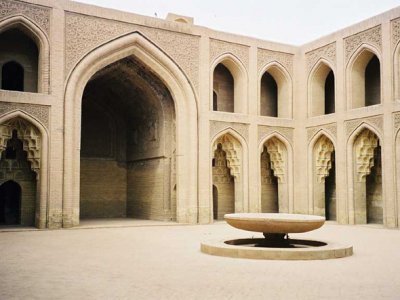
Actuala capitală a Irakului era la acea vreme în centrul ascensiunii fulminante a Islamului. Construcţia oraşului a început în 762, la ordinul califului Al Mansur, care a considerat că această zonă este cea mai potrivită pentru a ridica noua capitală a imperiului islamic. Se spune că forţa de muncă necesară pentru a construi Bagdadul în doar patru ani a fost de circa 100.000 de persoane, de la arhitecţi la ingineri. Construcţia a început în iulie, după cum reiese din unele izvoare scrise, pentru ca oraşul să se afle sub semnul zodiei leului. Timp de câteva secole Bagdad a fost centrul cultural al acestei părţi de lume, locul în care putea fi găsite şi studiate manuscrise de pe întreg mapamondul. În 1534 Bagdadul a fost cucerit de Imperiul Otoman. La scurt timp, în urma izbucnirii unor molime de ciumă şi holeră populaţia a scăzut cu circa o treime. În 1917 Bagdadul a trecut de sub stăpânirea otomană sub cea a imperiului colonial britanic. Începând cu 1932 Bagdadul a fost capitala Regatului Irak.
11. Kaifeng - anul 1.200. Populaţie: 1.000.000. Populaţie actuală: circa 5.000.000 în zona metropolitană
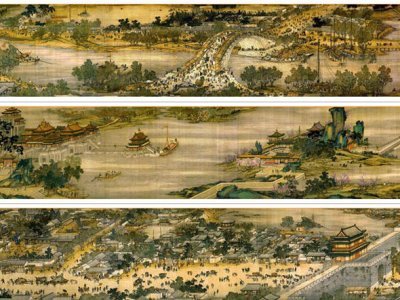
Fosta metropolă a imperiului chinez are astăzi rang de prefectură, mărginită geografic de către Fluviul Galben (Huang He) Xinxiang şi Shandong. Kaifeng este una dintre cele şapte foste capitale ale imperiului chinez.
12. Beijing - anul 1.500. Populaţie: 1.000.000. Populaţie actuală: similară cu cea a României - aproape 20.000.000 de locuitori
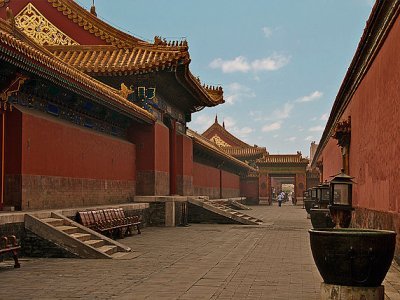
Actuala capitală a Chinei a fost fondată acum circa 3.000 de ani, înainte de tentativele repetate de unificare a statelor chineze. Beijing (care înseamnă "capitala din nord") a fost pentru prima dată capitala marelui imperiu chinez, cunoscută atunci sub numele de Dadu, sub dinastia mongolă Yuan. De atunci până astăzi, cu doar două "întreruperi" de circa 60 de ani în total, Beijing a ocupat rangul de capitală.
13. Ayutthaya - anul 1.700. Populaţie: 1.000.000. Populaţie actuală: sub 60.000 de locuitori
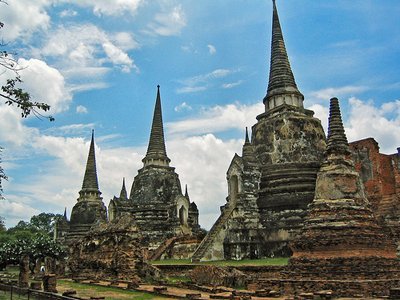
Actuala capitală a regiunii Ayutthaya din Tailanda a fost una dintre cele mai mari puteri comerciale şi armate din regiuni timp de patru secole. Unii diplomaţi francezi din secolele 17-18 au comparat oraşul cu Parisul în ceea ce priveşte bogăţia şi frumuseţea sa.
14. Londra - anul 1825. Populaţie: 1.335.000. Populaţie actuală: circa 14.000.000 de locuitori
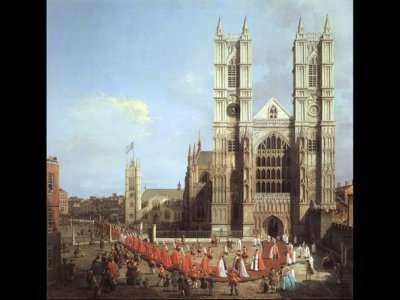
Capitala Marii Britanii şi al fostului imperiu colonial britanic a cunoscut o ascensiune fulminantă mai ales în timpul revoluţiei industriale determinate de descoperirea şi perfecţionarea motoarelor cu abur. În ziele noastre Londra este considerată, alături de New York, capitala financiară a lumii, partea Londrei în care îşi au sediul unele dintre cele mai mari grupuri financiare de pe plan global fiind denumită "The City", respectiv City-u londonez.
15. New York - anul 1925. Populaţie: 7.774.000. Populaţie actuală: similară cu cea a României - aproape 20.000.000 de locuitori

New York-ul modern a început să se dezvolte după 1914, când a fost inclus şi Bronxul ca al cincilea sector al oraşului. Printre cele mai celebre clădiri se numără Empire State Building, Chrysler Building şi Lincoln Building. Poate cea mai celebră stradă este Wall Street, unde îşi are sediul bursa americană dar şi majoritatea grupurilor financiare americane.
16. Tokyo - anul 1968. Populaţie actuală: peste 32.000.000 de locuitori

Capitala Japoniei este considerată de mulţi drept reprezentatul de vârf al celei mai bune perioade economice din istoria ţării, începută la începutul anilor 1950. Tokyo este una dintre cele 47 de prefecturi ale Japoniei. Zona metropolitană a oraşului a început să se dezvolte rapid după sfârşitul celui de-al Doilea Război Mondial. Este considerată una dintre cele trei mari "capitale economice" ale lumii, alături de New York şi de Londra. Iniţial Tokyo a fost cunoscută sub numele de Edo, care înseamnă estuar. În Era Meiji numele a fost schimbat în Tokei, variaţie fonetică chinezească a formei Tokyo, care înseamnă Capitala de Est.
CatalinCornea.ro: Cine este puterea regională? sau… Ce nu poate România, face Turcia!
 Turcia este una dintre ţările cel mai puţin afectate de criza care a început la sfârşitul anului 2008. Produsul Intern Brut al statului turc a crescut cu 10,2% în prima jumătate a anului 2010, marcând cea mai dinamică evoluţie din Europa. În acest context, Turcia continuă să uimească Europa prin politica ambițioasă a investițiilor publice: un nou canal de navigaţie care va lega Marea Neagră de Marea Marmara (o alternativă la Strâmtoarea Bosfor), calea ferată subterană Marmaray (care va face legătura între Europa şi Asia pe sub Canalul Bosfor) și mai nou construcția de avioane.
Turcia este una dintre ţările cel mai puţin afectate de criza care a început la sfârşitul anului 2008. Produsul Intern Brut al statului turc a crescut cu 10,2% în prima jumătate a anului 2010, marcând cea mai dinamică evoluţie din Europa. În acest context, Turcia continuă să uimească Europa prin politica ambițioasă a investițiilor publice: un nou canal de navigaţie care va lega Marea Neagră de Marea Marmara (o alternativă la Strâmtoarea Bosfor), calea ferată subterană Marmaray (care va face legătura între Europa şi Asia pe sub Canalul Bosfor) și mai nou construcția de avioane.Zilele trecute autorităţile turce au declarat că vor să înfiinţeze un operator aerian regional, care să-şi producă singur avioanele de pasageri pentru cursele de linie. Așadar, Turcia se apucă de construit avioane! Construcția de avioane pentru pasageri este o industrie exclusivistă, dominată de doi coloși: Boeing şi Airbus.
Foarte interesant este că o altă mare țară din regiunea Mării Negre începea construcția de avioane de pasageri încă în urmă cu 30 de ani… Avionul se numea ROMBAC 1-11 și după cum deja cred că v-ați dat seama era construit în România.
Primul avion a fost terminat în luna august 1982 și a fost prezentat presei și oficialităților române la 27 august 1982, fiind primul avion de pasageri cu reacție construit în România.
Înainte de 1989, Fabrica de Avioane București, actuala Romaero Băneasa, a construit 9 aparate de acest tip (plus două neterminate). ROMBAC 1-11 era la acel moment, singurul avion comercial cu reacție din Europa comunistă, cu excepția URSS, proiectul ROMBAC prevăzând a fi construite un număr total de 80 de avioane.
Care credeți ca a fost viitorul avionului comercial românesc?
Este limpede, nu-i așa?
Proiectul a fost abandonat, așa cum România a fost abandonată prăduitorilor care au administrat-o în perioada post comunistă (sau neo-comunistă)…
Dacă România nu a putut să își fructifice experiența și să continue construcția de avioane comerciale, probabil că o va face Turcia!
Succes!
Sursa: http://catalincornea.ro/2012/02/03/cine-este-puterea-regionala-sau-ce-nu-poate-romania-face-turcia/


